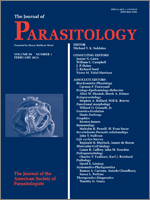The lung fluke, Haematoloechus longiplexus, is the most prevalent and abundant parasite of introduced bullfrogs on Vancouver Island, British Columbia, Canada. The ecological success of this trematode in invasive bullfrogs is related to the fluke's ability to utilize native intermediate hosts for transmission. The purpose of this study was to identify the odonate (dragonfly/damselfly) species involved in the transmission of H. longiplexus to the introduced bullfrog. The prevalences and mean intensities of 21 species of odonates (nymphs and adults) were examined for metacercariae infections. Haematoloechus longiplexus is a second intermediate host specialist, being found only in damselflies. Six damselfly species exhibiting the “climber” ecological habit were identified as second intermediate hosts of H. longiplexus. Enallagma carunculatum (prevalence = 75.0%, mean intensity = 17.2 ± 10.8), Ischnura cervula (65.2%, 8.9 ± 4.3), Ischnura perparva (45.5%, 15.4 ± 10.3), and Enallagma boreale (40.7%, 4.8 ± 7.8) were the most commonly infected damselfly species. Metacercariae were absent in damselflies collected from sites lacking bullfrogs. Haematoloechus longiplexus was likely introduced along with the bullfrog, and subsequently adapted to the physid snail and diverse damselfly intermediate hosts present in ponds on Vancouver Island.
How to translate text using browser tools
1 February 2013
Introduced Bullfrogs and Their Parasites: Haematoloechus longiplexus (Trematoda) Exploits Diverse Damselfly Intermediate Hosts on Vancouver Island
Colin W. Novak,
Timothy M. Goater
ACCESS THE FULL ARTICLE

Journal of Parasitology
Vol. 99 • No. 1
February 2013
Vol. 99 • No. 1
February 2013




